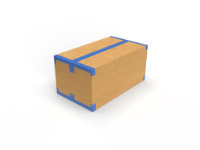NET illustration: Tape pattern
Finding the right solution for closing a cardboard box might seems easy, but can be a time-consuming affair if both strength properties and price should be taken in to account.
The choice of tape should be seen in the context of the selected tape pattern. Alternative patterns are often based on creativity and experience. To facilitate this work for new and experienced packers of dangerous goods as well as other types of goods, NET has made this simple overview based on our experience.
The overview shows each individual solution in addition to frequently used combinations of tape for packaging that are extra exposed to damage during transport. Sometimes the solution is also strengthened with straps.
The illustrations are all shown on an identical box. The boxes can of course vary a lot in shape and type, but the principle of taping will still be independent of what you choose as bottom / top, short side or long side.
Should you have other good solutions, we are happy to discuss these for possible implementation in our illustration.
| L pattern |  |
The tape goes only over thr edge, top- and bottom flaps |
| U pattern |  |
The tape joins the top and bottom flaps, and over the edge |
| L+U pattern |  |
The tape joins the top- and bottom flaps, and even some tape pieces over the edge of the top- and bottom flaps |
| H pattern |  |
The tape goes overthe flaps and the edges from corner to corner |
| H+ pattern |  |
The tape goes overthe flaps and the edges from corner to corner and straps across the flaps |
| O pattern |  |
Strong closing for standard box with tape around the entire box with a small overlap |
| O+ pattern |  |
Strong closing for standard box with tape around the entire box with a small overlap and straps across the flaps |
| X pattern |  |
The tape goes a cross the top and bottom flaps |
| C pattern |  |
The tape following the edges a cross the long side of the box |
| Ø pattern |  |
The tape following the edges a cross the top- and bottom of the box |

